Sending this toYeastspotting.
Click here for my blog index.

After weeks of driving, moving, and settling down, I've finally gotten my new kitchen more or less in order and ready to start baking/bloging again. Loving everything about Seattle so far, the active lifestyle, the urban living environment in downtown, the seafood, the "green" mentality -- I even like the grey weather! It's good for making laminated dough... :P
Now back to bread, this is a very Asian bread, I don't think I have seen anything similar in a western bakery. It's essentially the love child of Danish and Asian Style Soft Sandwich bread, inheriting the best qualities of both parties: nice and crispy on the outside, soft inside, and full of buttery goodness. While still a laminated dough, in order to rise high in the sandwich tin, it differes from croissants(tips here) and traditional danishs in following ways:
1. For croissants and danishs, we usually keep the dough fairly dry to ensure crisp and clean layers. While more kneading would make layers seperate more, resulting in a better crumb, we usually don't knead the dough to fully developement for the ease of rolling out. However, Asian style soft sandwich breads need to be kneaded very well to pass a very thin and strong windowpane test, otherwise the bread volume would suffer, and the texture won't be shreaddably soft (see details here). For this bread, we do knead the dough well (similar to other Asian style soft sandwich breads). In the mean time, the dough is kept pretty wet to have more extensibility, which make it possible to roll out.
2. Since the dough is fairly wet, and shaping procedure is different from traditional croissants, we don't expect as many honeycomb-like holes in the crumb, instead, crumb just need to be fairly even and open. In the mean time, the final dough doesn't need to be rolled out very thin (15mm instead of 4mm for croissants). For those reasons, the amount of roll-in butter is considerably less than croissants.
3. While for this particular batch in the first photo, I did one 4-fold, and two 3-folds, but this bread usually requires less folding than croissants. The most common method is one 4-fold, and one 3-fold, which I tried in another batch with good result.
In summary, since the dough requires less folds, and doesn't need to be rolled out very thin, it's an easier laminated dough than croissants and danishes. However, it does have different challenges: the intensive kneading to full developement, the final shaping which requires concise cutting and weighing, as well as braiding.
Laminated Sandwich Loaf (Adapted from many different sources)
Note: for details and tips on making croissants, please see this post
Note: for tips on kneading soft sandich loaves see this post
Note: this recipe makes about 930g of dough, less or more depending on how much you trim off the edges etc.
-levain
starter (100%), 44g
water, 75g
bread flour, 134g
1. mix and leave at room temp for 12 hours.
-final dough
bread flour, 361g
milk, 145g
egg, 77g
sugar, 60g
salt, 10g
instant yeast, 7g
butter, 41g, softened
levain, all
roll-in butter, 245g
1. Mix everything other than butter, knead until gluten starts to form. Add in butter, mix until fully developed. see this post for details.

2. Round, press flat, put in fridge immediately for 2 hours.
3. Make butter block, put in fridge for at least one hour before using. Take out the dough, roll out, and enclose butter. (see this post for details)
4. Roll out to 20X60CM, fold one 4-fold as in the following pictures. Put in fridge for one hour

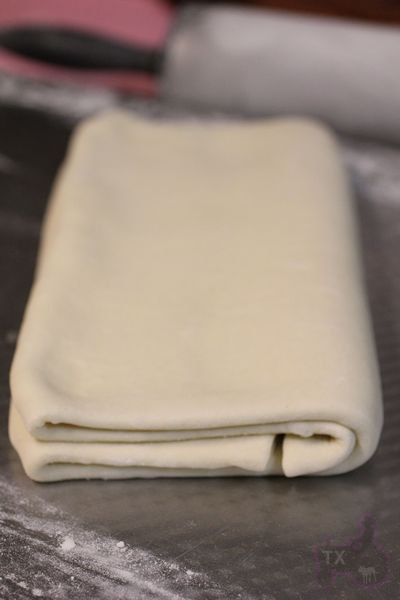
5. Roll out again and do one 3-fold, put in fridge for one hour. (see this post for details)
6. Repeat 5. (optional)
7. Roll out dough to 1.5CM-2CM thickness. Length of the dough piece would depend on the tin you use. Since we are braiding them, you will need the length to be about 2X length of the tin.
8. Cut the dough into thin pieces. This is where experience becomes important. We are braiding 3 pieces into one group, each group need to have a certain weight. Do note that if a tin requires more than one group of dough, each group should weigh the same, otherwise bread would appear uneven at the end. In another word, for each tin, select a weight for each dough group (less for flat top, more for round top), then stick to that weight for each group of dough.
a) For my bigger Chinese pullman tin (pictured on the left), I need 2 groups, each group has 3 pieces, and each group (all 3 pieces together) weigh 225-250g (225g if cover of the tin is used to make a flat top shape, more if cover is not used to make round top as in the picture).
b) For my small Chinese pullman tin, I only need one group of 3 pieces, each group (all 3 pieces together) weigh 150g (if cover of the tin is used to make top flat).
c) For 8X4 US loaf tin, I suggest to use 2 groups, each group has 3 pieces, and each group (all 3 pieces together) weigh 250-270g.
d) For KAF 13X4X4 pullman pan, I would suggest to use 4 groups, each group has 3 pieces, and each group (all 3 pieces together) weigh 195-215g.
9. For each group of 3 pieces of dough, braid them. Make sure the cut surface is facing up, to expose the layers. Fold ends under, put into tin.
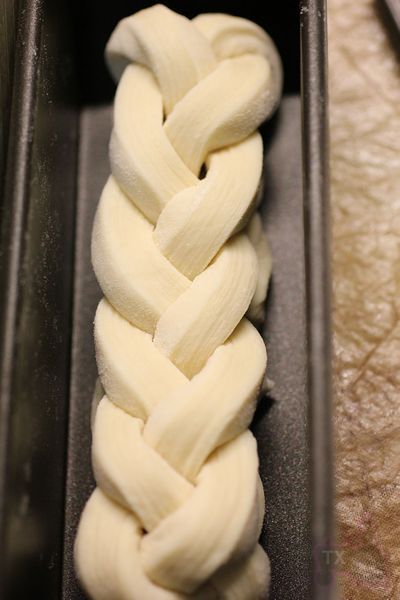
10. Proof at around 27C until 80-90% full, about 4-5 hours in my case. Egg wash if you are not using the pullman pan cover.
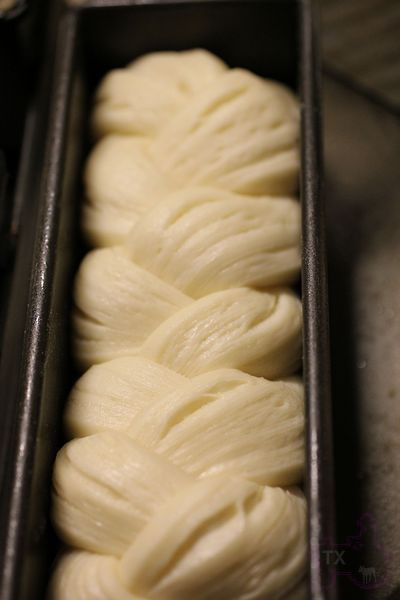
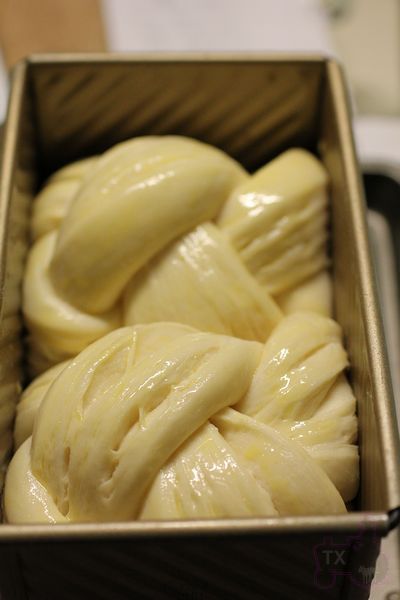
11: Bake at 425F for 10min, lowered to 375F and bake until done. The bigger Chinese tin which took 450g - 500g of dough, needed about 40-45min of TOTAL baking time. The smaller tin which took 150g of dough, needed 30min in total. If colors too much, cover with foil.
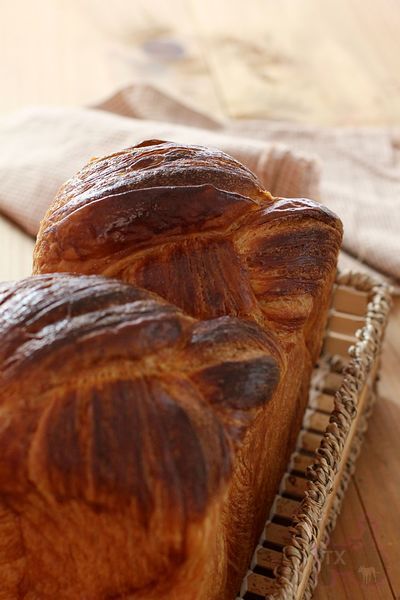
If the gluten network is fully developed, the bread should be proud and tall, with clear layers visible.
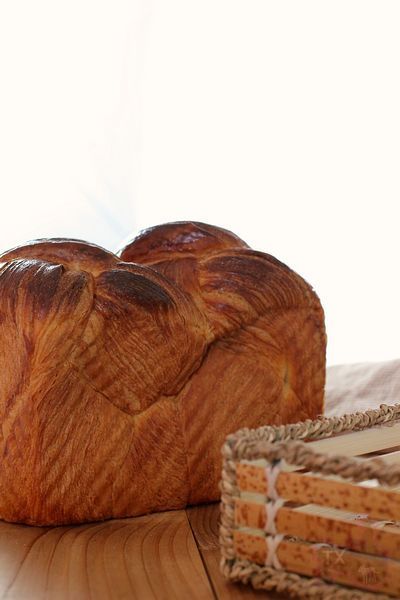
If the pan cover is used, the dough amount needs to be fairly accurate for the pan, other wise it's each too short (not reaching the top), or bursting out (the cover can literally be blown open). This neat rectangle shape is nicknamed "golden sticks".

The crumb soft but open with honeycomb structor.

In general, I feel it's easier than croissants, since you can fold less and doesn't have to roll out as thin. However, the success does depend on proper kneading and careful piecing and shaping.
